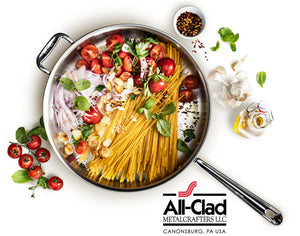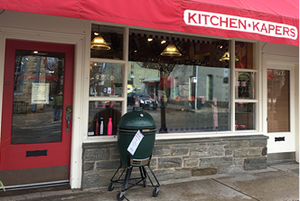Le Creuset Enameled Cast Iron Cookware is known for its quality. As with anything, there are steps you can take to care for your enameled cast iron which will help maintain its beauty. These instructions relate to Le Creuset's Enameled Cast Iron French Ovens, Saucepans, Skillets, Specialty Items like the Anniversary Pan, Casseroles, Au Gratins and Roasters. There are special use tips for Le Creuset Enameled Cast Iron Nonstick and for Le Creuset Enameled Cast Iron Grills & Griddles. Please refer to the sections below for specialized information on using, caring for, cleaning, and how Le Creuset cast iron cookware is made.
Shop our Collection of Le Creuset Cookware and see what's new!
Le Creuset Warranty Info.
Caring for your Le Creuset Enameled Cast Iron Cookware.
- Select low to medium heat for best results.
- Select the size of your heat source so that it is as close as possible to the base size of your pan. This will prevent energy loss and overheating of the handle.
- Gently pre-heat utensil on low setting for 2 - 3 minutes then add oil or liquid to the pan.
- Use only wooden, plastic or heat resistant nylon tools, to avoid scratching the enamel.
- Use a pot holder or oven glove to lift metal handled pans from the stove top or oven.
- Stand hot pans on a Le Creuset trivet, board or cloth, not directly on unprotected counter tops.
- When using pans on ceramic or halogen stovetops, always lift them (do not slide) to move.
- If a pan is banged against a hard surface or is dropped, it may chip or break.
- Pans with metal or heat resistant plastic handles may be used in the oven. The maximum temperature that should be used is 450°F or 232°C.
- Cool pans before washing in hot soapy water, rinse and dry thoroughly.
- Remove stubborn food residues with a plastic or sponge scourer only-do not use metal scourers or abrasive cleaners of any kind.
- Dry pans thoroughly after washing-do not leave to drain or put away while still damp.
- Pans with metal or plastic handles may be washed in a dishwasher. Wooden handled products should not be put in a dishwasher.
- Handles and knobs may become loose over a period of time. Check them once in a while and tighten as needed.
Cleaning your Le Creuset Enameled Cast Iron Cookware.
- After use, let pot or pan cool to room temperature. Wash in hot soapy water, rinse with warm water and dry.
- NEVER fill a hot pot or pan with cold water, or plunge into water for soaking. For stubborn clean-ups, fill cool pan with hot soapy water and let soak. Then, scrub with nylon brush or pad to clean.
- For stubborn stains, soak interior of vessel 2 - 3 hours with a solution of bleach consisting of one teaspoon of bleach per pint of water.
- NEVER use metal cleaning pads on the enamel surface. All Le Creuset products are dishwasher safe (except wood handles).
Helpful Hints
- Do not hit utensils on the top edge of pans.
- Always use a pot holder, handle glove or dry cloth to lift all pieces with metal handles.
- Stand hot pans on a Le Creuset trivet, board or cloth, not directly on an unprotected work top.
Heat
- Because of the heat retaining properties of cast iron, Le Creuset products do not require high heats at any time-use medium to low heat settings to maintain ideal cooking temperatures. High heats and subsequent overheating will permanently damage the surface.
- As a guide, on a gas stovetop, you can see the volume of heat by the size of the flame. A HIGH heat will produce a flame that extends to the edge of the product base. On a MEDIUM heat, the flame should extend to no more than half way across the base. On a LOW heat, the flame should just cover the central area. Very often there are indicators on the control knobs showing where the settings are for HIGH, MEDIUM and LOW.
- Le Creuset cast iron is suitable for all heat sources and is tested and approved by the Good Housekeeping Institute for use on glass-topped stovetops. However, owing to the natural weight of cast iron, it is advisable to lift the cookware on and off the burner instead of sliding them across the surface. Care should also be taken not to bang the cast iron down on the ceramic surface.
- Most importantly, use MEDIUM and LOW heat for best cooking results. This will minimize the risk of food sticking in the pan. Use high heat only for boiling water or water based cooking. For other cooking, heat pan slowly using a medium heat, then reduce to low.
- Use pots and pans which fit the burner size to assure proper heat dispersion. Placing a small pan on a large burner will result in the side walls becoming over-heated and the handles becoming damaged or too hot to handle.
- Always add food or liquid before heating. Do not heat an empty pan.
- Use wooden or heat resistant plastic or nylon tools for stirring on enameled surfaces. These are kinder to the enamel surface. Using metal tools occasionally will not hurt the cooking surface, but repeated use may cause scratches or abrasions.
- Heat Resistant Plastic:
- Products with these handles or knobs can be washed in a dishwasher. They can be used in an oven, but the maximum temperature should be no more than 450°F/232°C in order to protect the plastic. Care should also be taken not to leave these handles touching the hot oven sides as damage may occur. These handles are not resistant to the direct heat of a hot broiler. Such direct heat will cause damage by blistering and cracking the plastic.
- Phenolic knobs are heat proof to 450°F. Further, it is best to keep phenolic knobs away from the heating elements in an oven as the temperature in this area is generally hotter than the temperature throughout the oven.
- Metal:
- Some products have integral metal handles. These can be used in the oven or under a hot broiler, but the same maximum temperature given above apply (450°F/232°C). These handles will get hot. Always use a handle glove, oven mitt or dry cloth for lifting these pans.
- Tightening handles and knobs:
- Over time and when cookware is in constant use, the fixing screws for handles may loosen slightly. Occasionally check that the handles and knobs are fully tightened.
The Le Creuset base is hard-wearing, with a very smooth enameled finish applied to each piece. The smooth finish gives excellent heat diffusion and is very easy to keep clean. It also makes each piece suitable for all heat sources and all glass-topped stovetops, such as ceramic, halogen and induction. To maintain the appearance of this base, always 'lift' it on and off any stovetop or burner. DO NOT DRAG it across the surface and take care not to knock it or drop it against a hard surface. With a little care, your Le Creuset cookware will last for your lifetime.
Manufacturing Le Creuset Enameled Cast Iron.
Cast Iron allows for low heat cooking and provides unsurpassed heat retention. By enameling the cast iron, Le Creuset products do not require seasoning and will not react with foods (such as acidic tomato sauces).
In total, each piece is touched by 14 pairs of hands before it earns the Le Creuset name.
Steps used to make Le Creuset Enameled Cast Iron.
- Raw materials are melted at over 2000°F in a large cauldron shaped vessel (called a "creuset" in French).
- The molten iron is poured into a sand casting - this "mold" is destroyed after one use - so that each piece has a unique "fingerprint". The piece is cooled and removed from the mold.
- Each cast iron pan is scrutinized for imperfections. Rough edges and burrs are removed in a hand process called "fettling". Then each piece is blasted by tiny metal pellets to prepare a uniform surface for enameling.
- A "ground coat" of enamel is applied to the entire piece and fired in an oven at 1600°F. This grey color is what you see in the lip of the oven. No exposed iron is ever left on a piece of Le Creuset.
- Each item is then sprayed with two different coats of enamel. First the internal color then the familiar bright colored enamel on the exterior. Both are fired at 1450°F. This high heat firing embodies the enamel into the cast iron, making it almost completely resistant to damage during normal use.
- Final inspection of product, then packaged.
Individually created, coated, fired and inspected, each Le Creuset item is unique.
Le Creuset Enameled Cast Iron Questions & AnswersQ: Is Le Creuset's weight a benefit?
A: Yes. Heavy pots and pans such as those made by Le Creuset:
- Distribute heat more evenly.
- Ensure moisture and flavors are sealed in by heavy, tight fitting lids.
- Prevent pans from "dancing" on the stove top, freeing up an extra hand.
- Increase a pan's longevity by preventing warping or burning.
- Retain heat longer which keeps foods hot when serving.
Q: Is Le Creuset chip resistant?
A: Yes. Le Creuset's coating is porcelain enamel. Through normal use, Le Creuset is difficult to chip. Le Creuset's enamel coating is fired at 1450°F. Although the iron gives it strength, care should be taken not to drop Le Creuset or to strike it with hard objects. Also, thermal shock should be avoided.
Q: How do you clean the cookware?
A: Hand wash using a nylon brush or pad in warm, sudsy water to maintain the beauty of your finish.
Q: Can Le Creuset be washed in the dishwasher?
A: Yes, but not the pieces with wood handles. Since Le Creuset is very easy to clean, it is often easier to clean and dry by hand. We recommend hand washing in warm sudsy water with a nylon brush or pad to maintain the beauty of your finish.
Q: Can stains be removed without costly special cleaners?
A: Yes, by soaking 2 - 3 hours with a bleach solution of one teaspoon household bleach per pint of water.
Q: Is Le Creuset lead free?
A: Yes.
Q: Is the Glissemail interior stick resistant?
A: Yes, at low temperatures it is stick resistant, however it is not a Nonstick. Unlike Nonstick interiors, the Glissemail interior can withstand high heat on top of the stove, in the oven, or under the broiler which makes this interior very versatile.
Q: Does Le Creuset offer a Nonstick interior?
A: Yes, introduced in 2000, Le Creuset's unique Nonstick process combines a special base coat enamel plus three coats of Silverstone Nonstick. Designed for low temperatures and gentle cooking applications only.+-
Q: What temperature should you cook on?
A: Start on medium, which is the halfway point on the dial (5 out of 10) and decrease. Never cook above medium heat.
Q: What types of utensils should you use?
A: Wood or nylon. We don't recommend using metal utensils.
Q: Can I put cookware with knobs in the oven?
A: Yes, but don't heat the knobs over 450°F. Do not put the knobs under the broiler or near the heating elements in an oven since the surrounding area is hotter.
Q: Is it safe to use the cookware if the enamel is worn?
A: Yes.
Q: Is the enamel harmful if ingested?
A: No. It meets all FDA standards.




